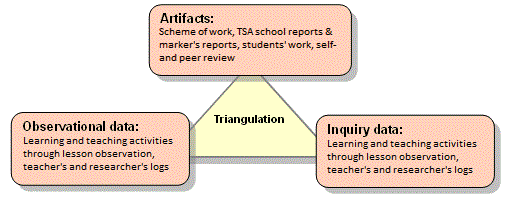I. Topic of the project
II. Purposes of the project
III. Strategies used
Data collection and analysis
As McLean (1995) states, the "implementation of a complete program of data collection and use can lead to the improvement of education." The process of data collection and use can help bring about changes in the curriculum. Such process is a cycle involving "acting, observing, and reflecting" (Holly et al, 2005) and should occur throughout rather than at the end of a study. "Interim analysis" (Huberman and Miles, 1998 and Hendricks, 2006) is important as part of ongoing reflective planning.
Multiple forms of data, including "artifacts", "observational data" and "inquiry data" (see again Hendricks, 2006) should be gathered for analysis. Then, a process of triangulation should be used to cross-check the different forms of data and ensure valid results.
Using pre-writing, revising and editing
"Pre-writing is a way of stimulating students' interest and, provide the basis for writing" (English Section & Institute of Language in Education, 1994). If appropriate support is given at this warm-up stage, the problems students encounter in writing can be addressed and students can write in an unthreatening atmosphere.
Walshe (1981) described writing as "potter's clay" which "only becomes a thing of usefulness or beauty through repeated smoothing and shaping".With supportive guidance, students can refine their work at the reviewing and editing stages. "Reading and responding" (White & Arnt, 1991) is a strategy which can help them review and edit their work.
As mentioned, the P3 teachers realised the importance of using a variety of data to identify students' needs. With reference to the school context, the P3 teachers collected a variety of data:

The data was analysed to help the teachers make informed decisions in a spiraling process.

IV. Design of the Project
The project was launched in December 2005 and lasted over a span of two terms. Process writing was used to design the writing modules and various data types were collected and analysed throughout the project.
Two writing modules were designed and implemented to address students' needs at different stages.
V. Assessment

